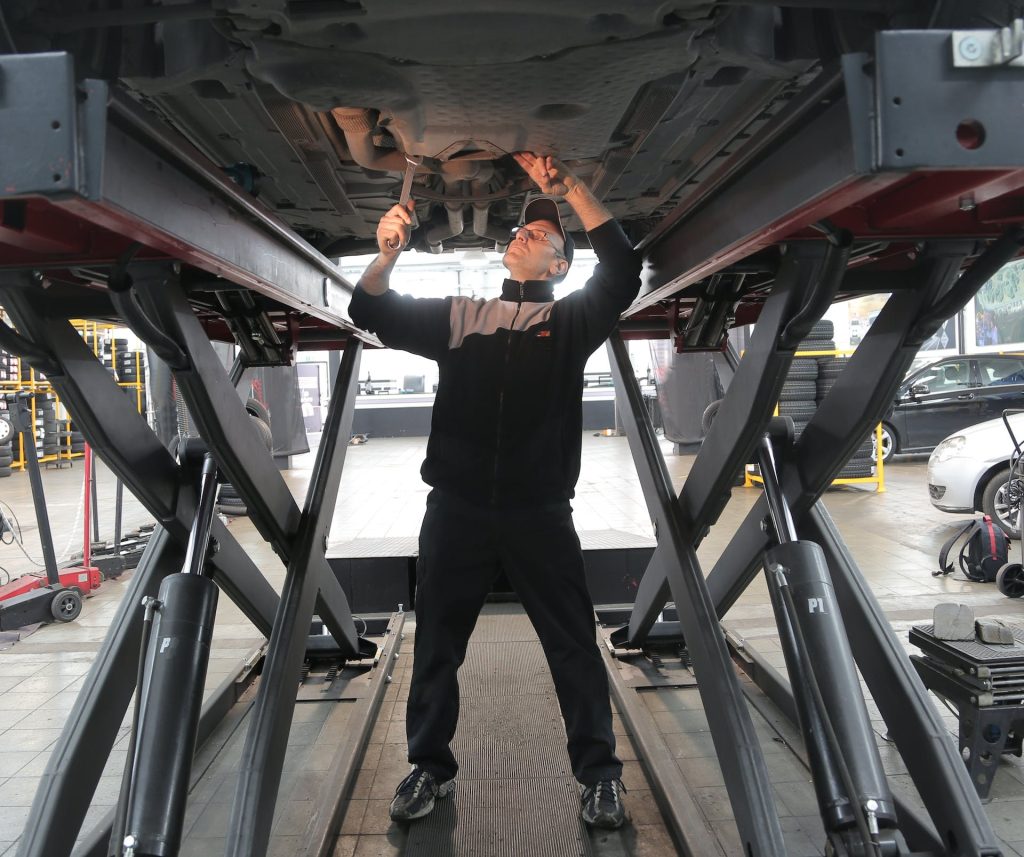Catalytic converter theft is a growing problem in the United States, costing car owners thousands of dollars in repairs and causing major inconvenience. Thieves target specific vehicles because their converters are easy to access and contain valuable precious metals like platinum, palladium, and rhodium.
CheapInsurance.com explores the top 10 targeted vehicles for catalytic converter thefts, according to reporting from CARFAX, and Car and Driver, and what steps are available for prevention and protection.
Key Takeaways:
- Top 10 Targeted Vehicles: Be extra vigilant if you own a Toyota Prius, Honda Accord, Ford F-Series truck, Toyota Tacoma, or other high-risk vehicles.
- VIN Etching: This simple and affordable measure deters thieves and aids recovery, potentially earning you insurance discounts.
- Catalytic Converter Cages: These sturdy shields add a strong layer of protection, significantly reducing theft risk and potentially lowering premiums.
- Comprehensive Coverage: Insure your car against theft with comprehensive coverage, remembering deductibles apply.
- Proactive Prevention Pays: Taking steps like VIN etching, using secure parking, and installing cages can save you money on repairs and potentially insurance premiums.

Top 10 Vehicles Targeted for Catalytic Converter Theft in the United States
- Toyota Prius: The Prius’ hybrid technology makes its catalytic converter particularly attractive to thieves due to its higher concentration of precious metals.
- Honda Accord: A popular and reliable sedan, the Accord’s readily accessible converter and widespread availability make it a prime target.
- Honda CR-V: Another popular Honda, the CR-V’s high ground clearance provides easy access for thieves to reach the converter.
- Ford F-Series Trucks: The best-selling vehicle in America, F-Series trucks are often targeted due to their high ground clearance and valuable converters.
- Toyota Tacoma: A popular mid-size pickup, the Tacoma’s increased theft rate in recent years is likely due to its rising value and ease of access to the converter.
- Chevrolet Silverado: Another popular full-size pickup truck, the Silverado’s valuable converter and ease of access make it a target for thieves.
- Ford Explorer: A popular SUV, the Explorer’s high ground clearance and readily accessible converter make it vulnerable to theft.
- Chevrolet Equinox: A popular compact SUV, the Equinox’s exposed converter and ease of access make it a target for thieves.
- Ford Econoline/E-Series Vans: These work vans often have catalytic converters located directly under the vehicle, making them easy to steal.
- Chevrolet Cruze: A popular compact sedan, the Cruze’s readily accessible converter and widespread availability make it a target for thieves.
Catalytic Converter replacement costs
The sting of losing your catalytic converter doesn’t end with the theft itself; replacing this vital component will significantly impact your wallet. The cost can range from a painful $600 to a gut-wrenching $2,500 on average, depending on your vehicle and the chosen replacement parts. The culprit behind this price range? The parts themselves can set you back anywhere from $300 for a basic, universal-fit converter to a whopping $2,250 for an original-equipment-manufacturer (OEM) replacement specific to your vehicle. Labor adds another layer to the cost, typically falling between $70 and $130 per hour, with the total time for installation varying depending on the specific car and converter access. So, prepare for a potential bill that could easily top $1,000, making proactive theft prevention even more crucial.
Tips for preventing catalytic converter theft:
- Park in well-lit areas with security cameras.
- Install a catalytic converter shield or cage.
- Get your vehicle’s VIN etched onto the converter.
- Be aware of the signs of catalytic converter theft, such as loud sawing noises or a strong exhaust smell.
- Report any suspicious activity to the police.
By following these tips, you can help deter thieves and protect your vehicle from catalytic converter theft.
VIN Etching: Adding a Layer of Discouragement to Catalytic Converter Theft
In the unfortunate reality of rising catalytic converter thefts, proactive measures offer crucial protection. One such measure is VIN etching, a simple yet effective method that can significantly deter thieves and aid recovery in case your converter is stolen.
How VIN Etching Works:
A unique identifier, typically your vehicle’s VIN number, is permanently etched onto the catalytic converter’s surface. This etching can be done using various methods, including:
- Dot peen marking: Tiny dots drilled into the surface form the VIN number.
- Chemical etching: A special acid burns the VIN number onto the converter.
- Laser etching: A high-powered laser burns the VIN permanently into the metal.
Why VIN Etching Helps Prevent Theft:
Etching discourages thieves in several ways:
- Increased risk of identification: Etched converters become readily identifiable, making them less marketable and reducing their potential resale value.
- Traceability: If recovered, an etched converter can be easily linked back to its rightful owner, facilitating investigation and prosecution of the thieves.
- Deterrence: Visible etching signals to potential thieves that the vehicle is protected, encouraging them to target easier prey.
Who Provides VIN Etching Services:
Several options are available for VIN etching:
- Auto repair shops: Many repair shops offer etching as a standalone service or combined with other maintenance work.
- Police departments: Some police departments hold public events or partner with local businesses to offer free or discounted etching.
- Mobile etching services: Companies offer on-site etching at your home or workplace for added convenience.
Average Cost of VIN Etching:
Prices for etching vary depending on the chosen method and provider. Typically, costs range from:
- $50-$100: For basic dot peen or chemical etching.
- $100-$200: For laser etching with higher permanence and visibility.
Remember: While VIN etching is a valuable deterrent, it should be combined with other preventative measures like parking in well-lit areas and installing protective shields for optimal protection.
Caging Your Concerns: How Catalytic Converter Cages Can Protect Your Investment
Catalytic converter theft is a rising concern, leaving car owners with hefty repair bills and a sense of violation. But fear not, for a metal knight stands guard: the catalytic converter cage. Let’s delve into this protective barrier and see how it can keep your precious converter safe.
What is a Catalytic Converter Cage?
Imagine a sturdy metal cage, custom-fitted to your vehicle’s undercarriage, encasing your catalytic converter like a protective cocoon. These cages are typically made from durable materials like steel or aluminum, forming a physical barrier against would-be thieves.
How Do They Prevent Theft?
Cages act as a multi-pronged defense system:
- Physical Deterrent: The cage’s visible presence discourages opportunistic thieves, as cutting through it takes time and effort, attracting unwanted attention.
- Slows Down Thieves: Even for determined thieves, the cage adds an extra layer of complexity, extending the time it takes to steal the converter, increasing the risk of getting caught.
- Protects Against Tools: The cage’s sturdy construction can withstand basic tools like saws and pry bars, making it a tough nut to crack for unprepared thieves.
Who Sells and Installs Them?
Several options exist for getting your car caged:
- Auto Repair Shops: Many shops offer cage installation as an add-on service during regular maintenance.
- Specialty Aftermarket Stores: These stores focus on car customization and security, often having a wider selection of cage options and experienced installers.
- Mobile Mechanics: Some mechanics offer on-site cage installation for added convenience.
Cost Considerations:
Cages vary in price depending on factors like material, vehicle type, and complexity of installation. Expect to spend roughly:
- $150-$300: For basic steel cages on easily accessible vehicles.
- $300-$500: For heavy-duty cages or vehicles with difficult-to-reach converters.
- $50-$100: For installation labor (may be included in the cage price).
Effectiveness: A Cagey Defense
While no security measure is foolproof, catalytic converter cages offer significant theft prevention:
- Studies show a 70-90% reduction in theft rates for vehicles with cages.
- Cages often deter less skilled thieves, who move on to easier targets.
- The added time and effort required to break through a cage can discourage even determined thieves.
Remember: Cages are just one piece of the puzzle. Combining them with VIN etching, parking in well-lit areas, and installing alarms can create a multi-layered defense against catalytic converter theft.

Don’t Get Left Converter-less: How Insurance Can Help
While catalytic converter theft can feel like a sudden, gut-wrenching blow, your car insurance might be able to ease the pain. Remember, understanding your policy is key, so let’s delve into the coverage details and navigate this bumpy road together.
While basic liability insurance covers damage you cause to others’ vehicles, it doesn’t extend to protecting your own car from theft. What can protect your vehicle is comprehensive coverage. While comprehensive coverage is typically an optional add-on to your policy if you own your vehicle, if you are financing or leasing your vehicle is it a required coverage. Comprehensive coverage shields your car from a wider range of perils, including:
- Theft: This includes catalytic converter theft, as the converter is considered a covered part of your vehicle.
- Fire: If a thief uses fire to access the converter, comprehensive coverage would kick in to cover the resulting damage.
- Vandalism: If the theft attempt damages other parts of your car, comprehensive coverage would help with repairs.
Remember the Deductible – Your Copay in this Crime Scene
While comprehensive coverage swoops in to save the day, it’s not a free pass. You’ll likely have a deductible, a specific amount you pay out-of-pocket before your insurance kicks in. So, if your catalytic converter replacement costs $1,000 and your deductible is $500, you’ll pay the initial $500, and your insurance covers the remaining $500.
Collision Coverage vs. Comprehensive: Know the Difference
Don’t confuse comprehensive coverage with collision coverage. Collision covers damage from accidents involving your car and another object, not theft. So, while a fender bender might be covered by collision, a stolen converter falls under comprehensive’s domain.
Filing a Claim: The Aftermath of a Converter Caper
If your catalytic converter becomes a target, here’s what to do:
- Report the theft to the police immediately. File a police report and obtain a copy for your insurance company.
- Contact your insurance company: Inform them about the theft and follow their claim filing procedures.
- Gather documentation: Provide any relevant paperwork, like your police report, repair estimates, and proof of ownership for the converter.
- Schedule repairs: Once your claim is approved, choose a qualified repair shop to replace the stolen converter.
Every insurance policy is unique, so carefully review your specific coverage details and limitations. Don’t hesitate to contact your insurance agent if you have any questions or concerns.
By understanding your comprehensive coverage and its role in catalytic converter theft, you can drive with a sense of security, knowing you’re not alone in facing this unfortunate crime. So, keep your insurance information handy, park in well-lit areas, and consider additional preventive measures like VIN etching or catalytic converter cages.
Theft-Proofing Your Wallet: Do Catalytic Converter Protections Lower Car Insurance Premiums?
The rising tide of catalytic converter thefts has left car owners scrambling for solutions. Could proactive measures like shields and cages, VIN etching and secure parking actually save you money on your car insurance? Let’s explore insurance discounts and see if you can turn theft prevention into financial gain.
The Allure of Discounts: Sweetening the Deal with Proactive Protection
Many insurance companies recognize the value of theft prevention measures. After all, a car less likely to be stolen translates to fewer claims payouts for them. This opens the door to potential discounts for taking steps to safeguard your catalytic converter, the prime target for these automotive pirates.
Catalytic Converter Protections in the Discount Spotlight:
- VIN Etching: This simple yet effective method of marking your converter with a unique identifier can deter thieves and aid recovery. Some insurers offer discounts of up to 5% for VIN-etched vehicles.
- Catalytic Converter Cages: These sturdy metal barriers physically shield your converter, making it a tough nut to crack for thieves. Discounts for cages can vary, but some insurers offer reductions of up to 10%.
- Secure Parking: Opting for well-lit, monitored parking spaces can decrease your car’s vulnerability to theft. While discounts specific to parking choices are less common, some insurers might offer broader theft prevention discounts that encompass secure parking practices.
Are there insurance companies that offer theft prevention discounts?
A handful of insurance companies do suggest some discounts for theft prevention measures, that may specifically include catalytic converter theft prevention measures. But it generally depends on the auto insurance policy you have/or purchase, and your specific coverage packages.
Reach out to your current insurer and ask about their specific discounts before exploring other options. You’ll be amazed at what proactive measures can do for your wallet and your peace of mind.
REMINDER: Discounts Depend on Your Insurer
It’s important to note that discount availability and percentages vary widely across insurance companies. What one insurer offers might not be available with another. Therefore, it’s crucial to:
- Contact your current insurer: Inquire about any specific discounts they offer for catalytic converter theft prevention measures.
- Shop around: Compare quotes from different insurers to see which ones offer the best discounts for your chosen theft prevention practices. Cheap car insurance that also provides quality protection may take some research to find, but it is worth the time and effort.
- Read the fine print: Carefully review the terms and conditions of any discounts you qualify for to understand any limitations or exclusions.

The Takeaway: Prevention Pays Off, in More Ways Than One
Protecting your catalytic converter isn’t just about safeguarding your car; it can potentially save you money on your insurance premiums. By actively reducing your car’s theft risk, you open doors to discounts and potentially lower overall premiums. So, invest in smart prevention measures, compare the best insurance quotes, and watch your wallet smile alongside your secure catalytic converter.


